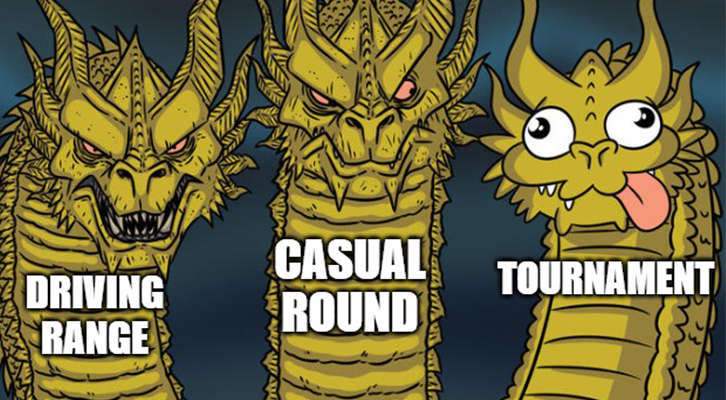If you’ve ever played in a golf tournament, you’ll likely never forget the feeling of stepping up to that first tee shot. I certainly remember mine. As I set my ball on the tee I had one thought: “don’t embarrass yourself.” So inevitably what I did was snap a duck hook directly into the trees lining the left side of the fairway. I never quite recovered from that for the rest of the round (I don’t think I broke 100 that day), and while I’ve had better experiences since then, it’s not one I’ll soon forget.
“Why can’t I play my best when it matters?” It’s a question that’s plagued golfers since the invention of the sport. While this can certainly lead to abstract discussions of luck or fate or “clutch genes”, there is a more straightforward answer: you’re not preparing yourself for the moment. Even if you’re an experienced golfer that generally plays by the Rules of Golf, there are likely things you do during a normal round that you wouldn’t in a tournament setting. So the question should be are you going to keep trying to make golf easier or are you ready to get better?
Here are 8 things to stop doing if you want to play better competitive golf:
Too Many Gimmies

Buzzfeed
It’s one of golf’s biggest unanswerable questions: when is a putt a gimmie? There’s tap-ins we all feel comfortable giving and there’s putts we all agree need to make it in the cup before we count it, but where exactly the line between the two falls is often up for debate. When you play in a tournament, though, the answer becomes crystal clear: you’re not done until the ball is in the hole.
If you want to relax the rules a bit during a casual round, that’s ultimately up to you. For the sake of pace of play and your mental health, I’m certainly not going to hold you accountable to grinding over every 3-footer for double bogey if there’s no stakes. But the more generous you are to yourself when it doesn’t matter, the less comfortable you’ll feel when you actually have to make that putt. Sure it looks easy at first glance, but when you’re standing over the ball with the pressure on, that putt suddenly starts looking a lot less than automatic.
Favorable Lies
:max_bytes(150000):strip_icc():format(webp)/bad-lie-587e21313df78c17b64eb72e.jpg)
Gary Newkirk/Getty Images
One of the fundamental tenets of the game of golf is to play it as it lies. Yet when most of us find ourselves with a ball that’s lodged on a tree root, plugged in some deep grass, or resting in someone else’s divot, our instinct is to bust out the old foot wedge and give yourself a better lie. The more honorable among us will count that as a stroke, but some don’t see the harm in shifting their ball a bit if it’s a non-competitive round.
Now obviously if you do this in a tournament setting and don’t take a penalty for moving the ball when you’re not allowed free relief, that’s just straight cheating. But by consistently choosing to give yourself an easier shot when you find yourself in a difficult position, you’re also robbing yourself of the opportunity to practice getting out of tough lies. It’s not something you can practice on the range and can be a useful skill for saving strokes in situations where every stroke matters. I’m not advocating putting yourself in a position that could lead to injury or damage your clubs, but for those times when the lie is just less than ideal, take a swing at it next time and become a better golfer for it.
Incorrect Penalty Procedures

Universal
Many golfers like to make the argument that hazards and OB should be treated the same and that golfers should be able to use stroke-and-distance any time a ball ends up on the wrong side of the colored stakes. It’s often easier to play it this way during the course of a normal round, but just know that’s not how it actually works. If you want to avoid the dreaded trek back to the tee box, make sure to hit a provisional if you think there’s any chance your ball went OB. Alternatively, when applicable, you can use the local rule that allows you to drop in the fairway parallel to where your ball crossed out of bounds with a two-stroke penalty (in other words, your next shot will be your fourth).
Breakfast Balls

Music Choice
Look, it sucks when you don’t have time to warm up before the round, so you roll up to the first tee ice cold and inevitably yank your drive onto the driving range or hit a dribbler that doesn’t even reach the forward tees. Does it feel better to get the bad shot out of your system, throw another ball on the tee, and stripe one down the middle? Sure it does. If you think your shanks are magically going to disappear when it’s tournament time and those first tee jitters kick in, though, you’re dreaming. There’s no do-overs in this game, so get used to it.
Count All Your Strokes

Sesame Street
The dreaded blow-up hole: after a series of wrong plays, mishits, and lost balls, you’re mercifully put out of your misery and forced to do that thing where you mime where each shot landed as you count up the final tally. In most cases, nobody wants to embarrass you by pointing out it was 11 shots instead of 10. Or maybe you just picked up your ball and marked down some form of max score. The World Handicap System even has a limit in this situation: when posting your score for handicap purposes, you shouldn’t take more than net double bogey (double bogey + any handicap strokes allocated for the hole).
However, depending on the format, you may not have any of these bailouts in a competition. In a traditional stroke play event, you can’t finish until the ball hits the bottom of the cup, no matter how long that takes. If you’re prone to having holes get away from you, you best figure out a way to stop that spiral or find yourself staring at some double digit numbers on your scorecard.
Post All Your Scores

CBC
Most seasoned golfers are familiar with the concept of “sandbagging”, where a golfer will artificially raise their Handicap Index in order to have a better chance at winning net competitions. When it comes to this topic, though, it’s time we reference sandbagging’s evil twin: the vanity handicap.
If you’re trying to keep your Handicap Index below a certain benchmark you’ve set for yourself, be better than your friends, or just trying to keep it as low as possible to appear better at golf, it could be tempting to ignore your worst scores or just stop keeping score altogether on a bad day. For one this isn’t going to help as much as you may think, as your Index is calculated using the best 8 of your 20 most recent rounds so those rough days will likely be thrown out anyway. Also, if you plan on actually using your Handicap Index instead of just showing off with it, you’re only making it more difficult on yourself to win anything. Let your scores speak for themselves.
Not sure where your Handicap Index is at these days? Get one here.
Practice Like You Play

NBA
If one phrase could sum up the message of this blog, this is it. Like most anything, getting good at golf is a matter of repetition, of doing the right thing the right way over and over again. I’m not saying you can’t relax and have a good time on the course or that you need to treat every round and range session like Sunday at Augusta. It’s simply about creating a consistent process in your game even when the results don’t matter.
You Don’t Play in Enough Tournaments

Disney
Before we wrap up, there’s one last thing to note here. Even if you do all of the things listed above, there’s still a good chance you’re scores will be higher when there’s stakes on the line. That’s because the only way to truly prepare for pressure situations is continuing to put yourself in them.
I’ve talked plenty here about the importance of making every round feel like a tournament, but the reverse is also true; the more you can make a tournament feel like a casual round, the better you’ll perform. You won’t know what it feels like to string together good shots when it matters most until you get out there and do it. The more you give yourself that opportunity, the easier it will be to replicate that experience.
If you’re struggling to play your best with the game on the line, you have two options: you can give up and stick to playing “just for fun”, or you can keep at it and unlock a new side of your golf game that you never knew existed (and have way more fun).
Need help finding your next tournament? The SCGA hosts tournaments year-round at courses across Southern California, open to all members. You can also join a golf club that hosts monthly events at your favorite courses.



